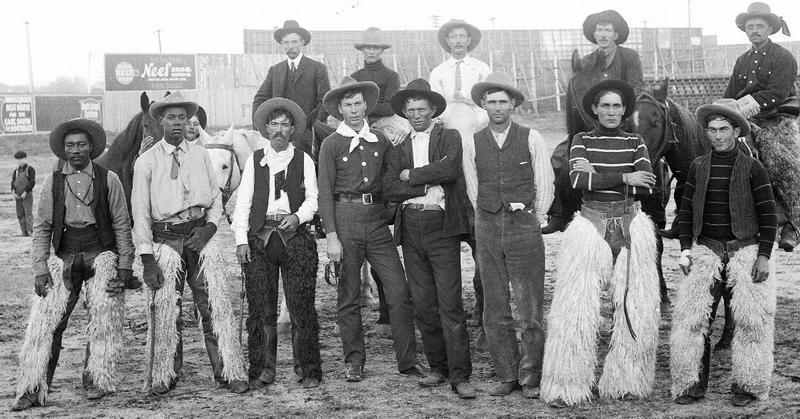Black And Mexican Cowboys Made Up At Least 25% Of The American West
By | September 12, 2020

When you think of the Wild West, you probably think of a lonesome cowboy who maybe looks a bit like John Wayne, out on his own, fighting the elements and struggling to survive the harsh conditions and brutal lawlessness of a vast and desolate countryside. While this image isn't exactly wrong, it's only a tiny fraction of the true picture of the West, which was a much more complex and diverse place than most modern cowboy tales depict. To really understand the cowboy's place in history, we first have to separate the cowboy as the literary hero archetype from the true cowboys who played a pivotal role in shaping the future of America.
Beyond Spaghetti
The cowboy hero trope exists in America today largely due to the hugely successful Western genre of film and television throughout the first half of the 20th century, it’s heyday finally closing out with the 1960s spaghetti Westerns of director Sergio Leone and actor Clint Eastwood. Over the decades, these films drew inspiration for their story lines and characters from a kind of pulp novel known as "dime novels," which were cheap and often inaccurate stories of true Western folk heroes. One popular literary star was, of course, "Buffalo" Bill Cody, who went onto popularize the genre further with a traveling theater show called Buffalo Bill's Wild West. Buffalo Bill has been criticized over the years for likely fudging some of the details of his past (like the fact that he was way too young to have ever ridden for the Pony Express), but he was a showman, after all. It's safe to say that, although compelling, these novels, shows, and movies were designed to entertain, not to depict a true picture of the American cowboy.

Mexican Cowboys
Who were the real cowboys, then? To find the true originals, we have to go all the way back to the turn of the 16th century, when the Spanish brought all the staples of the future Wild West—horses, cattle, and ranching—to the Americas. That's right, folks: Cows came from Europe, and while horses likely originated in North America, they died out in the region over 10,000 years ago and wouldn't step back onto their ancestral homestead until the Spanish reintroduced them in 1519. In light of that fact, it should come as no surprise that the original cowboys, known as the Vaqueros, were of Mexican origin. "Vaquero" would later become anglicized as "buckaroo," but most English speakers simply translated it to "cowboy." In fact, most words associated with cowboys are rooted in Spanish: "rodeo," "corral," "stampede," etc.

Lassos And Chuck Wagons
The arid and warm conditions of Mexico and what would eventually become the western United States were literally half a world away from the temperate climates of Europe, so only the toughest of cattle survived. One particularly durable breed was the Longhorn, which flourished in the dry heat of Texas. As their name suggests, they had very long horns that could measure anywhere from 3–6 feet across, so Vaqueros were tasked with the unique job of wrangling these unruly creatures. Sure, any cowpoke could throw a rope over a cow's head, but to truly tame the Longhorn, the Vaqueros pioneered the art of the lasso that would be aped by every cowboy wannabe who came after them.
As Spanish colonization claimed more and more of the Americas, cowboy culture came with it. By the 1800s, even regions as far west as California were getting wise to the lifestyle. While work on the open range was grueling and thankless, it was still viewed as "unskilled" labor and therefore often paid less than a dollar a day, or around $25–30 in today's money. Fortunately, they had the chuck wagon, which provided their meals, and it doesn't get much cheaper than sleeping under the stars. Still, such brutal work for such low pay was hardly desirable, so employment as a cowboy was available to pretty much anyone, regardless of race or social background.

Black Cowboys
With notions of Manifest Destiny and the passage of government incentives like the Homestead Act, many white citizens of the United States began to head west and make their claim on the land in the early and mid-1800s. As the West was less entrenched with the myriad legal and cultural restraints placed on black Americans during this time, many free men and women joined the trail with hope for a better life. The black population of the West boomed after the Civil War, and cowboying was an industry in which newly freed slaves could find steady work. It's estimated that in the decades following the Civil War, as many as 25% of cowboys were black.
That isn't to say that the black population didn't face discrimination in the towns of the Old West and within its laws, but in the tight-knit world of the cowboy, a person's worth was based on their work and character rather than their skin. As real-life black cowboy Nat Love put it, "A braver, truer set of men never lived than these wild sons of the plains whose home was in the saddle and their couch, mother earth, with the sky for a covering."
The era of open range cattle driving ended in the late 19th century, in large part thanks to the invention of barbed wire, which made it easier and cheaper for landowners to protect their property. Still, the cowboy has become a cultural icon, and ranchers across the Americas still practice their tried-and-true techniques. While the symbol of the Western cowboy will always stand for adventure, grit, and strength, perhaps it could stand to reflect industry's inclusivity as well.

